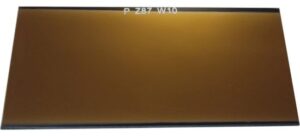
by James | Dec 2, 2023 | Safety Gears
Welding helmets once regarded purely as safety gear, have evolved into a canvas for creativity and innovation. Beyond their primary function of protecting welders from intense light, sparks, and debris, welding helmets now showcase a diverse range of designs that reflect individuality, technological advancements, and even cultural influences.
In this exploration of welding helmet designs, we delve into the evolution of these essential safety tools and the diverse aesthetics that adorn them.
1. From Function to Fashion: The Evolution of Welding Helmets
Traditionally, welding helmets were designed with a primary focus on functionality. The emphasis was on providing adequate protection for welders without much consideration for aesthetics. Early welding helmets were often bulky, made of heavy materials, and lacked the sleek features of contemporary designs.
However, as welding technology advanced and the demand for user-friendly equipment increased, manufacturers began to incorporate ergonomic designs and lightweight materials. This shift towards user comfort opened the door for more innovative and visually appealing helmet designs.
2. Beyond Basic Black: A Palette of Colors and Patterns
One of the most noticeable changes in welding helmet designs is the departure from the standard black or dark green colors. Modern welding helmets come in a variety of colors and patterns, allowing welders to express their style. From bold reds and blues to intricate patterns and graphic designs, the color palette has expanded, adding a touch of personality to the welding workspace.
Customization options are also on the rise, with some manufacturers offering personalized decals, stickers, or the ability to paint the helmet surface. This customization trend not only enhances the aesthetic appeal but also fosters a sense of ownership and pride among welders.
3. Art Meets Safety: Graphic Designs and Decals
Welding helmets have become a canvas for artistic expression, with graphic designs and decals becoming increasingly popular. Iconic symbols, intricate illustrations, and even company logos can be incorporated into the helmet design. This allows welders to showcase their individuality while adhering to safety standards.
Some welding helmet manufacturers collaborate with artists to create limited-edition designs, turning these safety essentials into collector’s items. These collaborations contribute to the blurring of lines between industrial gear and art, elevating the status of welding helmets from mere tools to statement pieces.
4. High-Tech Helmets: Integrating Technology with Design
Advancements in technology have not only improved the safety features of welding helmets but have also opened up new possibilities in terms of design. Auto-darkening helmets, for example, incorporate LCD technology that adjusts the lens shade based on the intensity of the welding arc. This technological innovation has allowed for sleeker, more streamlined helmet designs without a traditional flip-up visor.
Additionally, some high-tech helmets come equipped with features like built-in cameras, augmented reality (AR) displays, and Bluetooth connectivity. While enhancing functionality, these features also contribute to a futuristic and cutting-edge aesthetic, transforming welding helmets into high-tech accessories.
5. Cultural Influences: Reflecting Diversity in Design
Welding hood designs are not only shaped by technological advancements but also by cultural influences. In regions where welding is deeply ingrained in the local culture, helmet designs may feature traditional symbols, folklore, or artistic styles specific to that community. This infusion of cultural elements adds a unique flair to the designs and fosters a sense of connection between the welder and their craft.
Here are some welding helmets with different kinds of designs. So have a look at their design and features.
Jackson Safety PL 280 Welding Hood for Pipeline
The Jackson Safety PL280 is a compact bucket-shaped welding helmet, ideal for pipeline work. Made from super tough lightweight nylon, it is designed for easy access to tight spaces and is especially suitable for surface welding. This durability makes it reliable for handling the toughest harsh welding conditions.
This helmet features a useful spring-loaded elevator face, which allows welders to wear the helmet during preparation and welding of the rear portion It is equipped with a high-impact polycarbonate window that ANSI Z87.1+ / CSA Z94 Meets .1 certifications, and a standard 2” x 4.25” Shade 10-hole this ensures safety and clear vision when in use.
For added comfort, the PL280 includes a patented 370 Speed Dial ratcheting headgear, which makes it smooth and adjustable. The design is also compatible with cartridge respirators, making it versatile. In addition, the helmet’s super cool coating effectively reduces heat buildup by up to 30%, increasing comfort over long welding periods.
Lincoln Electric Viking 1740 Ignition™ Welding Helmet
The helmet features 4C lens technology, which allows for truly colorful arc and mud vision. This new technology increases welding control, improves welding efficiency and reduces eye strain. In addition, the lens boasts an excellent 1/1/1/1 optical clarity rating, eliminating common lens issues like blurring and distortion, and ensuring consistent brightness and performance from parts of the
Comfort is key to the helmet’s design, featuring raised padding on the head arch for maximum comfort during long welding sessions Another notable feature is the Grind Mode Indicator – a green LED that glows in metal the inside of the helmet and shows the user when the helmet is set to grind mode of grinding
The helmet is customizable for welding needs, offering shades that change from 9 to 13. It is also designed to facilitate a customized welding experience with sensitivity and delay controls, powered by AAA batteries the function changes, ensuring that the helmet is always ready for use without interruption.
Forney – 55860 Smoking Rose ADF Welding Helmet
The Forney Series welding helmets are designed with comfort and safety in mind. Its lightweight and fire-resistant shell, combined with a double crown belt head valve ensures a perfect fit. Versatile head adjustments and quick, 5-point gear headphones with sweat belts are specifically designed to reduce head and neck strain, making them ideal for the long haul for use in welding operations
The helmet has a viewing area of 5.97 square inches, providing a large area for a clear view of the welding area. This is enhanced by high visual clarity and true technology, creating a natural and vivid viewing experience. The protection is further enhanced by two optical pressure sensors and a UV/IR coating that protects the lenses from scratches and discolouration.
Functionality is an important feature of the Forney Series helmet. Featuring an external shade select knob with a grind option for quick adjustments, and internal sensitive delay controls for individual settings Adherence to various CE, DIN, ISO, EN, and ANSI safety standards, this helmet is reliable and user-friendly for DIY enthusiasts, small contractors and those on farms Welding equipment is needed, they have a good selection
Conclusion: Where Safety and Style Converge
In the realm of welding, where safety is paramount, the evolution of welding helmet designs has beautifully merged practicality with style. From basic black to a vibrant spectrum of colors, from traditional symbols to cutting-edge technology, welding helmets now reflect the diverse tastes and preferences of welders worldwide.
James is a welding expert, accomplished author, and trusted guide with over 8 years of experience in the industry. With his in-depth knowledge and engaging writing style, James has become a true authority in the field, offering readers and clients invaluable expertise and insights to take their welding skills to new heights.

by James | Nov 2, 2023 | Safety Gears
Welcome to the fun world of Anime Welding Helmets! These special helmets let welders show off their love for anime while staying safe at work. They come in many cool designs, featuring popular anime characters, essentially transforming the conventional welding helmet into a vibrant anime welding mask. It’s like adding a bit of personal style to the usual safety gear, creating a unique welding helmet anime experience. Welders of all levels, whether they’re using an anime welding cap or helmet, can find something they like, making their work more enjoyable.
In this blog, we’ll take a closer look at these cool helmets, discussing the different styles and how they help keep welders safe. Whether you’re new to welding or have been doing it for years, you’ll see how these helmets can make your day better with their unique anime welding mask designs. So, get ready to learn about the awesome world of Anime Welding Helmets with us!
Read More: Top Welding Helmet Under $200
The Unique Design of Anime Welding Helmets
Anime welding helmets stand out in the world of protective gear, offering a unique blend of safety and style that captures the essence of Japanese animation. These helmets are not just practical tools for welders; they are a canvas for vibrant artwork and intricate designs inspired by beloved anime characters and themes. The attention to detail in these designs is truly remarkable, with bold colors and dynamic illustrations that bring the characters to life. With designs ranging from subtle anime welding caps to full-fledged anime welding masks, there’s something for every anime fan.
The helmets serve as a form of personal expression, allowing welders to showcase their passion for anime and connect with a community of like-minded individuals. Beyond the aesthetic appeal, the designs are also functional, with large viewing areas that provide clear visibility, ensuring that the welder’s work is precise and accurate. The helmets are equipped with auto-darkening filters that quickly adjust to varying levels of brightness, protecting the welder’s eyes from harmful rays.
Manufacturers of anime welding helmets pay close attention to both form and function, ensuring that the helmets meet industry safety standards while providing a comfortable fit. Adjustable straps and padded interiors enhance the user experience, making it easy for welders to wear the helmets for extended periods. Whether you choose a subtle anime welding cap or a bold anime welding mask, you’re guaranteed a product that balances style with safety. Also, check our top picks for Pancake welding helmets.
Safety Features of Anime Welding Helmets
Anime Welding Helmets offer more than just striking visuals; they are also equipped with a plethora of safety features to ensure the utmost protection for welders. The primary function of any welding helmet, be it a conventional design or an anime welding mask, is to safeguard the eyes and face from sparks, spatter, and harmful radiation, and these helmets do not compromise safety.
One of the key safety features is the auto-darkening filter (ADF), which instantaneously adjusts the lens’s darkness in response to the welding arc’s brightness. This ensures that the welder, even if they’re wearing an anime welding cap, has optimal visibility without risking exposure to harmful rays. The ADF is powered by a combination of solar cells and batteries, ensuring reliability and longevity.
The helmets also provide full face and neck coverage, protecting the skin from UV and infrared radiation. The materials used are flame-resistant and durable, ensuring that the helmet, whether it’s a standard design or an anime welding mask, can withstand the rigors of welding work. Adjustable headbands ensure a secure fit, preventing the helmet from slipping and exposing the welder to potential hazards.
Ventilation is another crucial aspect of the helmet’s design, ensuring that welders remain comfortable and cool, even during extended use. This reduces the risk of heat stress and allows for better concentration and precision in work, whether you’re wearing a standard helmet or an anime welding cap.
How Anime Welding Helmets Not Compromise on Safety?
Anime Welding Helmets despite their playful and vibrant exterior, uphold the highest standards of safety to ensure the well-being of welders. These helmets are crafted with advanced technology and robust materials, ensuring they do not compromise on crucial safety features, even in designs as whimsical as an anime welding mask.
At the forefront of their safety design is the auto-darkening filter (ADF) lens. This feature swiftly adjusts the level of shade in response to the brightness of the welding arc, providing optimal visibility while shielding the eyes from harmful ultraviolet and infrared radiation. The quick response time of the ADF ensures immediate protection, which is crucial for preventing eye strain and potential damage.
The helmets also provide extensive coverage, shielding not just the eyes, but the entire face and neck area from sparks, spatter, and harmful rays. The material used for the helmet’s shell is designed to be flame-resistant and durable, capable of withstanding high temperatures and impact, adding an extra layer of protection, whether you’re wearing a standard design or an anime welding cap.
Comfort is also a key component of safety, and these helmets are designed with adjustable headbands and padded interiors to ensure a snug and secure fit. This prevents the helmet from shifting during work, which could potentially expose the welder to hazards, regardless of whether they’re wearing an anime welding mask or a conventional helmet.
Caring for Your Anime Welding Helmet
Maintaining the integrity and functionality of your Anime Welding Helmet, be it an anime welding cap or a full helmet, is crucial to ensure it provides optimum protection and has a long-lasting life. Proper care and maintenance are essential, and here’s how you can achieve that:
Firstly, regular cleaning is vital. Wipe the helmet’s exterior with a soft, damp cloth to remove dust and dirt. For the lens, use a clean, lint-free cloth and lens-cleaning solution to prevent scratches and maintain clear visibility. Ensure that the sensors on the auto-darkening lens are free from dirt and obstructions to function correctly, even if your helmet features an anime welding mask design.
Storage also plays a significant role in the helmet’s longevity. When not in use, store the helmet in a clean, dry place away from direct sunlight, as UV rays can damage the auto-darkening filter over time. If the helmet comes with a storage bag, use it to protect against dust and scratches, ensuring your anime welding cap or helmet stays in top condition.
Regularly inspect the helmet for any signs of wear and tear, especially the headgear, as a secure fit is essential for safety. Replace any worn-out or damaged parts promptly. Ensure that the battery for the auto-darkening lens (if applicable) is in good condition and replace it as per the manufacturer’s recommendations.
Lastly, handle the helmet with care. Avoid dropping it, as impacts can damage the auto-darkening filter and the helmet’s structure, compromising its protective capabilities, whether it’s a standard design or an anime welding mask.
By following these simple yet effective care and maintenance tips, your Anime Welding Helmet will continue to provide reliable protection and maintain its vibrant design, ensuring you can weld safely and in style, no matter if you choose a subtle anime welding cap or a bold anime welding mask.
Conclusion
Anime Welding Helmets have revolutionized personal protective equipment, perfectly blending top-notch safety with anime-inspired designs. These helmets provide all the necessary protection with auto-darkening filters and durable construction while allowing welders to express their individuality. In doing so, they prove that safety and style can coexist, setting a new trend in the industry and making a strong case for personal expression in the workplace, whether through an anime welding mask, helmet, or anime welding cap.
Read More: What is Minion Welding Hood
James is a welding expert, accomplished author, and trusted guide with over 8 years of experience in the industry. With his in-depth knowledge and engaging writing style, James has become a true authority in the field, offering readers and clients invaluable expertise and insights to take their welding skills to new heights.
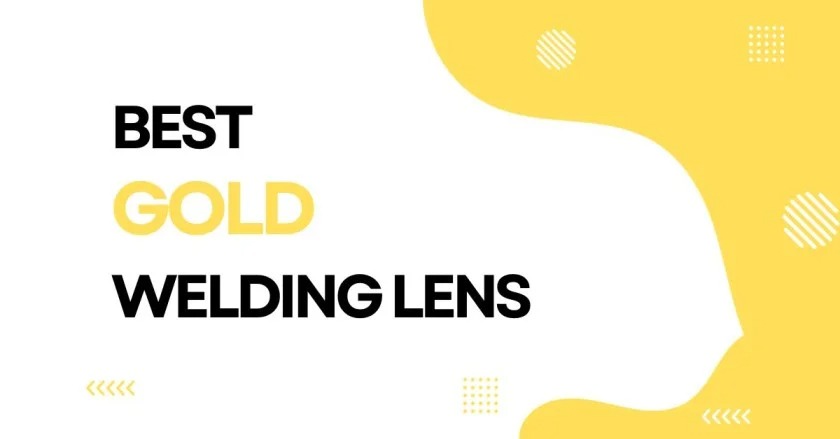
by James | Nov 2, 2023 | Product Reviews, Safety Gears
The welding lens is a vital component that shields welders’ eyes from the intense brightness and harmful radiation generated during the welding process. The choice of a welding lens is not to be taken lightly, as it can greatly affect a welder’s comfort, productivity, and long-term eye health.
Gold welding lenses have gained recognition for their exceptional qualities, which surpass those of traditional lenses. Their unique attributes not only enhance a welder’s visibility and clarity but also reduce eye strain and protect against the invisible threats of UV and IR radiation.
Let’s dive in and discover how gold welding lenses can make a world of difference in your welding journey. Here are some of the top gold welding lenses that you can consider for your welding.
Tefuawe 2×4 1/4 Gold Welding Lens
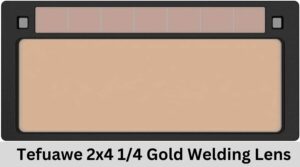
Elevate your welding precision with the Tefuawe 2×4 1/4 Gold Welding Lens. Its gold coating rejects 99% of UV&IR, ensuring cooler operation and reduced eye strain. Ultra-thin at 0.19″, it seamlessly fits all 2×4-1/4″ welding hoods and accommodates cheater glass. Experience flicker-free low Amp TIG with a remarkable 5A minimum rating.
The high-heat-resistant housing minimizes lens failures, catering to industrial needs. Enjoy a high-definition view for precise arc recognition and superior welds. Tefuawe True Color Lens technology in light state 3 provides a brighter, natural view, enhancing productivity by reducing the need for frequent helmet flipping. Backed by a worry-free 1-year warranty and 24/7 lifetime customer service, it’s a reliable choice for welders.
TrueArc Gold Auto-Darkening HD Welding Lens
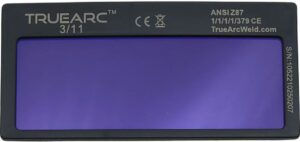
TrueArc Gold Auto-Darkening HD Welding Lens featuring TrueArc HD Technology that reflects and absorbs 99.99% of infrared and ultraviolet radiations, ensuring crystal-clear views of the arc and puddle. With a Light Shade of DIN3, it provides an ultra-clear view of the work area, enhancing the quality and performance of your work. Stay focused and relaxed with high-quality, consistent performance that minimizes blurriness and distortion.
Completely automatic and solar-powered, the lens triggers the LCD into its dark shade in less than 0.5 milliseconds, eliminating the need for battery replacements. Compatible with most 2″ x 4 1/4″ welding hoods, including Pancake, Pipeliner, and Tigerhoods, it comes in shades 10 and 11 to meet your specific needs. Backed by a 1-year warranty and a commitment to customer satisfaction, TrueArc guarantees fast and easy replacements or refunds. Each product undergoes inspection before shipment, ensuring reliability. For a clear, safe, and efficient welding experience, trust the TrueArc Gold Auto-Darkening HD Welding Lens.
Shade 10 Glass GOLD 2″ x 4.25″ Welding Hood Lens
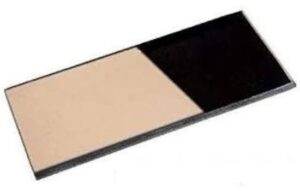
AmeriArc Gold Coated HD Auto Darkening Welding Lens
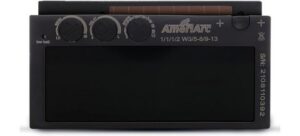
Understanding the Basics of Welding Lenses
Here, we’ll explore the basics of welding lenses to give you a solid foundation for understanding the advantages of gold welding lenses.
Types of Welding Lenses
Passive Welding Lenses
Passive lenses have been the traditional choice for welders for decades. They are made of dark-tinted glass, which is fixed at a specific shade level, often around shade 10.
Passive lenses do not automatically adjust to changing light conditions and require the welder to manually raise and lower the helmet visor when transitioning between welding and inspecting the workpiece. While they are simple and reliable, passive lenses can be less convenient in applications that involve frequent starts and stops.
Auto-Darkening Welding Lenses
Auto-darkening lenses are a modern innovation that has revolutionized the welding industry. They are equipped with sensors that detect the intensity of the arc and automatically adjust the shade level accordingly. This dynamic adjustment means welders no longer need to repeatedly flip their visors up and down, resulting in increased productivity and less neck strain.
Auto-darkening lenses provide a clear view of the workpiece when not welding and instantly darken when the arc is struck, protecting the welder’s eyes.
Key Features to Consider in a Welding Lens
Shade Level
The shade level of a lens determines the darkness of the lens when the arc is active. The appropriate shade level varies depending on the welding process, materials, and amperage. Common shades range from 9 to 13.
Viewing Area
A larger viewing area provides better visibility and comfort, allowing welders to see their work clearly without constantly adjusting their helmets.
Clarity
Lens clarity refers to how well welders can see the workpiece and their surroundings through the lens. Quality lenses offer high optical clarity, reducing eye strain and fatigue.
Importance of Eye Protection in Welding
Welding is a high-intensity process that emits intense light, heat, and harmful radiation, making eye protection an absolute necessity. Failing to protect your eyes adequately can lead to short-term discomfort and long-term vision damage. Here’s why welding lenses are essential:
Arc Intensity
The welding arc emits intense light, including ultraviolet (UV) and infrared (IR) radiation. Exposure to these forms of radiation without proper protection can cause severe eye damage, similar to sunburn.
Molten Metal and Sparks
Welding often produces flying sparks, molten metal droplets, and slag that can cause eye injuries if they make contact with unprotected eyes.
Fumes and Particles
Welding also generates fumes and particles, which can irritate and damage the eyes if inhaled or come into contact with the ocular surface.
Types of Gold Welding Lenses
Gold welding lenses come in various shades and styles to suit different welding applications and preferences. They offer exceptional optical clarity and protection against harmful radiation. Here, we’ll explore the common types and shades of gold welding lenses available in the market:
Gold-Coated Lenses
These lenses have a thin layer of gold coating on the surface, usually applied through a vapor deposition process. Gold-coated lenses are designed to enhance optical clarity and reduce glare.
Benefits
- Improved visibility with reduced eye strain.
- Enhanced color recognition, making it easier to distinguish between materials.
- Effective protection against harmful UV and IR radiation.
Gold-Shaded Lenses
Gold-shaded lenses incorporate a gold-tinted color into the lens material, providing a distinct visual experience.
Benefits
- Reduced glare and increased contrast can be especially useful when working with reflective or polished materials.
- Enhanced clarity and comfort.
Common shades include light gold, medium gold, and dark gold, allowing you to choose the level of tint that suits your specific welding application.
Auto-Darkening Gold Lenses
Auto-darkening gold lenses combine the benefits of gold-coated or gold-shaded lenses with the convenience of auto-darkening technology. These lenses automatically adjust their shade level in response to the welding arc’s intensity, ensuring optimal protection and visibility.
Benefits
- Seamless transition from light to dark, reducing the need to constantly raise and lower the helmet visor.
- Enhanced color recognition and clarity, even in challenging lighting conditions.
Gold Mirror Lenses
Gold mirror lenses have a reflective gold coating on the exterior surface. This mirror-like finish serves multiple purposes:
Benefits
- Reflective properties reduce heat absorption, keeping the lens and the welder’s face cooler.
- Improved optical clarity, reduced glare, and better contrast.
Gold mirror lenses are especially valuable in high-heat welding environments, where heat management is essential.
When choosing a gold welding lens, it’s important to consider the specific requirements of your welding tasks. Factors like the welding process, materials, amperage, and personal preferences all play a role in selecting the right type and shade of gold lens.
Experimenting with different shades can help you find the one that offers the best balance between visibility, protection, and comfort for your particular welding applications.
How to Choose the Best Gold Welding Lens?
Selecting the best gold welding lens is a crucial decision that can significantly impact your welding experience. To make an informed choice, consider the following factors and follow these steps:
Welding Process and Intensity
Welding Process
The type of welding you do (MIG, TIG, stick, or plasma cutting) will influence your choice of gold welding lens. Some processes emit more intense light and radiation, requiring a darker lens. Also, read our guide on the best shade lens for MIG welding.
Amperage and Intensity
Higher amperage welding typically produces a more intense arc. Consult your welding machine’s specifications to determine the appropriate shade range for your specific welding setup.
Shade Level
Gold welding lenses come in various shades, including light, medium, and dark gold. The shade level should be selected based on the welding process, amperage, and the specific materials you work with. Consider starting with a medium shade and adjusting from there based on your needs.
Comfort and Fit
The fit and comfort of your welding helmet and lens are paramount. Uncomfortable equipment can lead to fatigue and decreased productivity.
Ensure that the lens is compatible with your welding helmet, and if possible, try it on before purchase to ensure it fits comfortably and securely.
Budget Considerations
Set a budget for your gold welding lens, but be mindful that quality and features can vary significantly among different brands and models.
While cost is an important factor, prioritize quality and features that align with your specific welding needs.
Consider Special Features
Some gold welding lenses come with additional features such as anti-fog, anti-scratch coatings, or innovative designs for heat management. Assess if these extra features are important for your specific needs.
Compliance with Safety Standards
Ensure that the gold welding lens complies with relevant safety standards and certifications. Your safety is paramount, and using a lens that meets industry safety guidelines is essential.
Advantages of Using Gold Welding Lenses
Let’s dive into what makes gold welding lenses shine and why they have become a preferred choice for welders around the globe.
Enhanced Visibility and Clarity
The enhanced clarity can be attributed to the gold coating or tint, which filters out unwanted glare and brightness, making it easier for welders to see their workpieces with greater precision. Here’s how this enhanced visibility benefits welders:
- Welders can work for longer periods without experiencing the eye fatigue associated with squinting or straining to see clearly. Enhanced visibility results in greater comfort and productivity.
- The improved clarity allows welders to monitor the weld puddle more effectively, leading to more precise and aesthetically pleasing welds.
- Gold lenses offer excellent color recognition, enabling welders to distinguish between different materials and identify imperfections or inconsistencies more easily.
Reduced Eye Strain and Fatigue
Gold welding lenses significantly reduce eye strain, which is critical for the long-term health of a welder’s eyes:
- The reduced glare and eye strain provide a more comfortable and less tiring welding experience, allowing welders to remain focused on their work.
- Fatigue and eye strain can lead to lapses in concentration, potentially causing welding mistakes or accidents. Gold lenses promote safety by ensuring welders remain alert and attentive.
Protection against Harmful UV and IR Radiation
Gold welding lenses not only enhance visibility but also provide robust protection against harmful ultraviolet (UV) and infrared (IR) radiation. The benefits of this protection include:
- Continuous exposure to UV and IR radiation can lead to eye damage, including welder’s flash, which is painful and potentially permanent. Gold lenses act as a barrier, safeguarding the welder’s eyes from these dangers.
- Prolonged UV and IR exposure is associated with an increased risk of cataracts. Gold lenses contribute to preserving eye health and preventing such conditions.
- Using a gold lens aligns with safety standards and regulations, ensuring a safe working environment and compliance with occupational safety guidelines.
Enhanced Comfort and Efficiency
Gold welding lenses not only protect and clarify but also contribute to comfort and efficiency in welding:
- The auto-darkening feature in some gold lenses ensures that welders don’t need to repeatedly flip their visors up and down. This seamless transition enhances efficiency and reduces neck strain.
- Whether welding indoors or outdoors, gold lenses adapt to different lighting conditions, providing consistent comfort and protection.
- Greater comfort and visibility directly translate into better weld quality and reduced rework, which can save time and resources.
Conclusion
As you embark on your welding journey or seek to improve your current setup, we hope this guide has shed light on the brilliance of gold welding lenses and provided you with the knowledge needed to make an educated choice.
Remember, the right lens can make all the difference, ensuring not only the quality of your work but also the health of your eyes. Whether you’re a seasoned professional, a passionate hobbyist, or someone considering a future in welding, the right gold welding lens is your steadfast companion in achieving the highest standards of safety, precision, and comfort.
Read More: Cheater Lenses for Welding Helmets
James is a welding expert, accomplished author, and trusted guide with over 8 years of experience in the industry. With his in-depth knowledge and engaging writing style, James has become a true authority in the field, offering readers and clients invaluable expertise and insights to take their welding skills to new heights.

by James | Nov 1, 2023 | Product Reviews, Welding Machines
In the world of welding, finding the right equipment can be a daunting task, especially when you’re on a tight budget. For those in need of versatile welding machines that can handle various tasks without breaking the bank, multi-process welders are the answer. In this blog, we will embark on a journey to explore the world of multi-process welding on a budget.
Let’s explore the world of multi-process welders under $500 and discover how you can achieve outstanding results without breaking the bank.
Understanding Multi-Process Welders
Multi-process welders, as the name suggests, are versatile welding machines that offer the capability to perform multiple welding processes using a single device. These processes typically include MIG (Metal Inert Gas), TIG (Tungsten Inert Gas), and stick welding (Shielded Metal Arc Welding or SMAW).
The ability to switch between these welding methods makes multi-process welders a valuable tool for welders of all levels, from beginners to professionals.
Top Picks for Multi-Process Welders under $500
Now that we’ve covered the basics of multi-process welders and why they’re so versatile, let’s dive into the specific models that offer excellent performance without breaking the bank. Here are our top picks for multi-process welders under $500:
The YESWELDER Digital MIG-205DS Multi-Process Welder stands out as an exceptional value for its versatile capabilities and budget-friendly price under $500. Supporting MIG, Flux-core, TIG, and Stick welding processes, it’s a dynamic 4-in-1 solution. The dual voltage support of 110v/220v enhances flexibility for various welding needs, delivering a maximum power output of 205A, capable of welding up to 3/4-inch thickness.
The Synergic MIG controls offer both automated and manual modes, ensuring a stable arc and minimal spatter, providing an excellent MIG welding experience. With a high-duty cycle of 60% at 205A and 100% at 158A, this lightweight welder at just 23 lbs is perfect for hobbyists seeking a reliable and versatile tool for various welding applications.
Though it doesn’t support a spool gun for aluminum welding, its affordability, portability, and multi-process features make it one of the best budget MIG welders available.
Stick welding, MIG welding, and DC TIG welding are the three processes used by the Forney Easy Weld 140 MP Multi Process machine. It uses up to 1/8 in. of welding rod and can weld up to 1/4 in.
Depending on the type of MIG wire chosen, this unit may require gas or none at all. With the 140 MP welder from Forney, you can make something new or fix something old.
Features
- 3 in 1 stick welder, MIG welder, and DC TIG welding.
- You can quickly switch between processes with the three-position switch.
- You can achieve the ideal weld by adjusting the wire feed speed and voltage to an infinite degree.
- Rated output voltage range: 12-23V
- Rated output current range: 43-110A
- Full Output current range: 10-140A
Rugged metal case. Large enough to hold wire rolls weighing two and ten pounds. Complete metal wire drive setup.
This multi-process welding machine has an optional spool gun connector and is suitable for stick/MMA, gas/solid wire MIG, gasless flux core MIG, spot welding, lift TIG, and other processes.
Pre-flow/post-flow, burn-back adjustment, and adaptive crater are just a few of the unique features that this MIG welder offers to increase welding efficiency. It is Ideal for outdoor maintenance, farm and road equipment, and DIY projects at home. It is lightweight and comes with a handle and a shoulder strap.
Pros
- 6-in-1 MIG Welder.
- Capable of welding stainless steel, mild steel, and aluminum (MIG).
- Dual voltage 110V/220V.
- Switch on VRD to avoid electric shock.
- Innovative LED screen design for human-computer interaction.
This multi process welding machine is entirely digital with an intelligent control system at a single knob. The voltage and current can automatically adjust and make up for it. This welder with spool MIG function easily works with a spool gun.
With 20 levels of precise adjustment ranging from -20V to +20V, this welder offers coordinated speed control for the wire feeder.
Pros
- 3-in-1 Multi-Process Welder
- Duty cycle:
- 60% @ 225A at 25 oC in 220V
- 100%@ 200A at 25 oC
- Dual Voltage: 110/220V
- Comes with an energy-saving fan cooling system
Factors to Consider When Choosing a Multi Process Welder
When choosing a multi-process welder, several crucial factors should be taken into consideration to ensure that you make the right investment. Here are the key factors to keep in mind:
Supported Welding Processes:
Determine which welding processes you need. Multi-process welders typically offer MIG, TIG, and stick welding capabilities, but some models may focus on specific methods. Ensure that the welder supports the processes relevant to your projects.
Duty Cycle:
The duty cycle indicates the amount of time a welder can operate at a specific amperage level within a 10-minute cycle without overheating. A higher duty cycle allows for longer welding sessions. Consider your welding needs and choose a welder with an appropriate duty cycle for your tasks.
Input Power Requirements:
Check the voltage and amperage requirements of the welder. Some multi-process welders are designed to work with standard household 120V outlets, while others may require 220V. Ensure that your power source can accommodate the machine’s requirements.
Portability and Size:
Consider the portability of the welder, especially if you need to move it to different job sites. Look for lightweight and compact models that are easy to transport. Additionally, verify that the welder’s physical dimensions fit your workspace.
Build Quality and Durability:
Assess the construction and build quality of the welder. Look for models made from sturdy materials and with robust internal components. A durable welder will last longer and withstand the demands of various welding tasks.
Safety Features:
Safety should be a top priority. Ensure that the welder has built-in safety features such as overload protection, thermal shutdown, and a reliable grounding system. The presence of these safety measures can prevent accidents and protect both you and the equipment.
Ease of Use and Controls:
Consider the user-friendliness of the welder. Look for intuitive controls and displays that make it easy to adjust settings and monitor your welding parameters. This is especially important for beginners.
Accessories and Compatibility:
Check whether the welder comes with essential accessories like welding guns, torches, and cables. Also, verify that it’s compatible with a wide range of consumables and accessories, as this can affect your overall welding experience.
Warranty and Customer Support:
Research the manufacturer’s warranty and the availability of customer support. A good warranty can provide peace of mind, and responsive customer support can be invaluable if you encounter issues or have questions.
Budget:
While we’re discussing budget multi-process welders, it’s important to find a model that fits within your budget constraints. Compare the features, specifications, and reviews to ensure that you’re getting the best value for your money.
Conclusion
Finding a multi process welder under $500 that delivers solid performance on a budget is indeed possible. These versatile machines offer the flexibility to tackle a range of welding tasks, making them valuable assets for welders of all skill levels.
Our top picks, such as the Forney, ARCCAPTAIN, and Hynade offer diverse options to suit different welding needs and preferences. These models strike a balance between affordability and functionality, providing reliable performance without stretching your budget.
Whether you’re a DIY enthusiast, a hobbyist, or a professional welder, these budget-friendly multi-process welders can empower you to take on various projects with confidence.
Read More: Top Multi Process Welders Under $1000
James is a welding expert, accomplished author, and trusted guide with over 8 years of experience in the industry. With his in-depth knowledge and engaging writing style, James has become a true authority in the field, offering readers and clients invaluable expertise and insights to take their welding skills to new heights.

by James | Oct 29, 2023 | Product Reviews
Top MIG Welders under $500
Surprisingly, some of the industry’s biggest companies sell feature-rich machines for less than $500. We’ve done the legwork for you, scouring the market for three worthwhile low-cost MIG welders.
Eastwood 180 Amp MIG Welder is a powerhouse of innovation and portability. Weighing in at less than 26 lbs, this welder operates seamlessly on both 120 and 240 volts, offering unparalleled versatility. From welding mild and stainless steel to aluminum, its capabilities span from 24 gauge to 5/16″. The latest IGBT inverter technology provides a welding range of 30-180 amps, complemented by a metal drive motor for the smoothest operation.
With 2T/4T modes, a Tack Weld setting, and compatibility with .023 – .035 wire in 4″ and 8″ spools, this welder ensures comfort, efficiency, and precision. Backed by Eastwood’s renowned quality and a 3-year limited warranty, it’s a testament to over 40 years of commitment to excellence.
Safety is paramount, and the Eastwood 180 Amp MIG Welder includes essential precautions, making it a reliable choice for professionals and beginners alike. Satisfaction guaranteed since 1978, this welder comes with a 90-day return policy, offering a perfect blend of performance and peace of mind.
The Forney Easy Weld 140 MP stands as a pinnacle of versatility in the welding realm, seamlessly integrating three essential processes – Stick, MIG, and DC TIG welding – all within one compact machine. Its user-friendly design, highlighted by an easy start feature and a three-position switch for quick process changes, makes it an ideal choice for both beginners and experienced welders.
Precision is at your fingertips with infinite voltage and wire feed speed controls, allowing you to dial in the perfect weld. Encased in a rugged all-metal structure, this welder is built to withstand the rigors of daily use, accommodating 2 and 10-pound rolls of wire effortlessly.
The comprehensive package includes a 10′ MIG gun, 8′ electrode holder, 8′ ground clamp, integrated handle with torch wrap, 20A – 15A adapter, and an additional .030″ contact tip. With dimensions of 14.19″ x 19.31″ x 11.61″ and a weight of 24.81
The YESWELDER 135Amp MIG Welder is a powerhouse in a compact package. With an impressive 135 Amp output, it effortlessly handles welding mild steel up to 2/5” in thickness, supporting .030” and .035” flux core wire. Its multi-process capabilities, including Gasless MIG, Stick, and Lift TIG welding (additional tig lift torch required), make it a versatile 3-in-1 welder.
The user-friendly design ensures simplicity with automatic voltage and wire feeding speed adjustments by amperage. Safety features like automatic compensation for voltage fluctuation, over-current protection, and overload protection prioritize user safety. Weighing just 11.4 lbs, this lightweight and portable welder is your go-to solution for welding tasks on the go.
Key Features to Look for in a MIG Welder under $500
The key features to look for in a MIG welder under $500 are:
- Power Output
- Duty Cycle
- Versatility
- Portability
- User-Friendly Interface
Power Output
The power output or amperage of the MIG welder is an important feature to consider. The power output of the MIG welder is determined by the thickness and type of material. A MIG welder under $500 is suitable for light to medium-duty welding jobs.
Duty Cycle
The duty cycle of a welder specifies how long it can operate continuously at a certain amperage. The duty cycle is usually represented as a percentage. The MIG welders under $500 have duty cycles suited for intermittent welding.
Versatility
The versatility of a MIG welder is its ability to handle a variety of materials, such as mild steel, stainless steel, and aluminum. Customizable models let you fine-tune the welder for different materials and thicknesses.
Portability
Portability is a critical feature for on-the-go welding. Consider the welder’s size and weight. Compact and lightweight models are suitable for welding on the fly.
User-Friendly Interface
A user-friendly interface with clear controls and setup instructions is a critical feature. A MIG welder with a user interface that simplifies the process of selecting wire feed speed and voltage settings is useful for novice or infrequent users.
Some additional features to look for in a MIG welder under $500 are thermal overload protection, wire-feed speed and voltage settings, spool gun compatibility, and gas or gasless operation.
Read More: Best 110V MIG Welders
Essential Components and Functionality of MIG Welders
The basic components of MIG welders are:
- Welding Gun
- Wire Electrode
- Shielding Gas
Welding Gun
The MIG gun is an essential component of a MIG welding setup. The primary function of a welding gun is to:
- Feed the Wire Electrode
- Provide Shielding Gas
The welding gun contains a spool of consumable wire electrodes. The gun feeds the wire at a steady rate as you squeeze the trigger. A nozzle on the front of the welding gun delivers shielding gas. This shielding gas prevents weld flaws. The design of the welding gun is critical. The ergonomics of the welding gun are important in preventing tiredness.
Wire Electrode
There are various types of wire electrodes. They can be solid wire and flux-cored wire. Solid wire is utilized with a shielding gas. Flux-cored wire has a shielding flux core. Flux-cored wire is suitable for outdoor welding.
The wire electrodes are made up of mild steel, stainless steel, and aluminum. Greater efficiency in welding is achieved if the material of the wire matches with the material to be welded. The diameter of the wire electrode should be suitable for welding. Thicker wire diameters are suitable for welding thicker materials. Thinner wire diameters are better for thinner materials and precision work.
Shielding Gas
Shielding gas is essential in MIG welding. Shielding gas’s principal function is to produce a protective atmosphere. It displaces ambient gases and avoids the production of porosity and weld spatter.
Common shielding gases are argon and carbon dioxide. The type of gas used is determined by the material being welded. Pure argon is frequently used for welding nonferrous metals. An argon-carbon dioxide mixture is excellent for carbon steel. A proper gas flow is required for effective shielding.
Conclusion
Choosing the finest MIG welder under $500 can be a worthwhile undertaking. There are low-cost choices available for MIG welders that provide outstanding performance and versatility. You can make a good investment that allows you to move on with your welding projects both affordably and efficiently. By selecting the appropriate MIG welder, you will ensure that your welding job remains of excellent quality which creates a win-win situation.
James is a welding expert, accomplished author, and trusted guide with over 8 years of experience in the industry. With his in-depth knowledge and engaging writing style, James has become a true authority in the field, offering readers and clients invaluable expertise and insights to take their welding skills to new heights.








